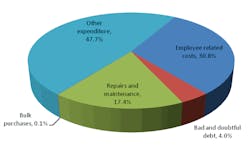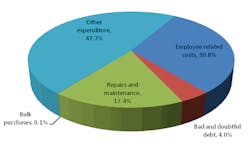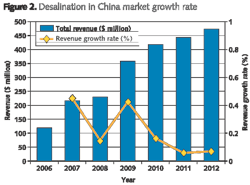How Sustainable is Europe's Water Footprint?
The end of February saw the Global Water Footprint Standard published. Spain's government has already included water footprint assessment into policy, making it part of the process to develop river basin plans. Could the rest of Europe follow? Professor Arjen Hoekstra looks at the concepts of blue, green and grey water footprints.
The water footprint of Europe – the total volume of water used for producing all commodities consumed by European citizens – has been significantly externalised to other parts of the world. Europe is for example a large importer of cotton, one of the most thirsty crops. Coffee is imported from Colombia, soybean from Brazil, rice from Thailand; the list goes on. European consumption strongly relies on the water resources available outside Europe.
Since the pressure on freshwater resources outside Europe is growing, due to population growth, increasing levels of production and climate change, an emerging and vital question is: how sustainable is Europe's water footprint? Can Europeans continue to rely on water resources elsewhere given the growing number of instances of water overexploitation in some of the places from where Europe imports water-intensive consumer goods?
The external footprint of European consumption
In its current form, Europe's Water Framework Directive, although one of the most modern and advanced pieces of water legislation in the world, will not provide a solution for Europe's largest water challenge. Europe's water management strategy is to take river basins as the starting point for policy formulation. This is a very sound approach, but insufficient, since it assumes that water challenges can be fully solved within the boundaries of a river basin. This, however, is a misconception. Water-intensive products like food, feed, cotton, flowers, timber, paper and bio-energy are intensively traded between nations, where traded commodities cross river basin boundaries as well. All European countries import and export water in virtual form, that is in the form of agricultural and industrial commodities. But in the end, all countries in Europe have net import, which means that they use some water for making export products but more water is used elsewhere to produce the commodities that are imported.
Europe as a whole is a net importer of virtual water. Europe's water footprint significantly lies in the Americas, Asia, Africa and Australia. A substantial part of existing problems of water depletion and pollution in the world relates to export to Europe. And what's important from a geopolitical point of view: Europe's water security strongly depends on external water resources.
Southern versus Northern Europe
Of all regions in the world, Europe makes the biggest claim on water resources elsewhere. With increasing competition over scarce freshwater resources it is doubtful whether Europe can continue to rely on external water resources to the same extent as today. China is currently quickly externalising its water footprint, among others to Africa. Australia has intensively used its water resources in the past for making export products, but the increasing water scarcity problems in for example the Murray-Darling basin will force Australia to critically review its export policy. These sorts of global developments imply that Europe will probably have to optimise the use of its own water resources for increased domestic production of water-intensive goods.
The external developments will probably create additional water demands within Europe that would not have occurred without those external developments. If it comes to accommodating the additional water demand for producing water-intensive commodities like food, feed and bio-energy, there is a difference between Southern and Northern Europe. Despite regular water shortages in Southern Europe, this part of Europe still produces water-intensive crops for export.
Water-scarce countries such as Spain and Greece for example still use large volumes of water to produce fruits, tomatoes and oil crops for export. Under most climate change scenarios, Southern Europe will experience more droughts, so that using water for export crops becomes increasingly questionable. Climate change is also expected to cause drier summers in large parts of Northern Europe, but there is still potential for growth in crop production. The overall picture is thus that there will be a gradual shift of water-demanding activities from other parts of the world to Europe and, within Europe, from Southern to Northern Europe.
The water footprint of traded commodities
Freshwater is increasingly recognised as a global scarce resource. Every single traded commodity has a water footprint. The table below shows the global average water footprint of some major food commodities. The water footprint of a commodity is the total volume of freshwater used to produce the product, summed over the various steps of the production chain.
Water use is measured in terms of water volumes consumed (evaporated or incorporated into a product) or polluted per unit of time. The blue water footprint is the volume of surface and groundwater consumed during the production process. The green water footprint is the volume of rainwater consumed and the grey water footprint of a product is an indicator of freshwater pollution that can be associated with the production of a product over its full supply chain. It is defined as the volume of freshwater that is required to assimilate the load of pollutants based on natural background concentrations and existing ambient water quality standards. There are two reasons why there is a growing interest in understanding the water footprint of traded commodities.
The first is that water-scarce countries are forced to review the relation between trade and national water scarcity. Obviously, domestic water scarcity can be reduced by externalising the water footprint of national consumption, that is by relying more on virtual water imports. The second reason is that consumers are increasingly interested in sustainable products, which means that there is growing interest in where products come from, how they are produced and whether the water footprints in the various production steps are sustainable.
In this context, the phrase sustainable means that in the catchments where production steps take place, environmental flow requirements and ambient water quality standards are met and that no social conflict over water does occur. It also means that no unnecessary waste or pollution of water does occur.
Global Water Footprint Standard
In order to help governments and companies using the same language, on February 28 this year, the Global Water Footprint Standard was published as a result of a process led by the Water Footprint Network. The ‘water footprint' is an analytical tool to address policy questions of water security and sustainable water use.
The standard defines terminology and covers a comprehensive set of methods for water footprint accounting. It shows how water footprints are calculated for individual processes and products, as well as for consumers, nations and businesses. It also includes methods for water footprint sustainability assessment and a library of water footprint response options. A shared standard on definitions and calculation methods is crucial, given the rapidly growing interest in companies and governments to use water footprint accounts as a basis for formulating sustainable water strategies and policies.
Policy integration in Spain
The Spanish government has been the first government that has incorporated water footprint assessment into policy, by making water footprint analysis an obligatory part of the process of developing river basin plans. Water footprint assessment is a tool that can help governments understand how different production processes contribute to the total water footprint in the various river basins relevant to the nation. It can also help to list the final products that relate to the water consumption and pollution within a river basin. An important question, most urgent in water-scarce basins has to be asked: is the water allocated and used in a wise manner, which protects minimum environmental water requirements and quality standards and yields the highest societal value from the water consumed?
Bigfoot: Europe as a whole is a net importer of virtual water and its footprint significantly lies in the Americas, Asia, Africa and Australia
It will often appear that particular contributions to the total water footprint within a basin are not so smart, for example when scarce water resources are unnecessarily polluted or consumed for making cheap water-intensive export products. In such cases, the added value of the water use is low, while the environmental or societal cost is high.
When one shifts the focus on the water footprint within a country or river basin to a focus on the water footprint of the consumers living in a country or river basin, one will be able to discover the link between consumption in one area and problems of water depletion and pollution elsewhere. When tracing the hidden water use behind imported products, governments will face the question of how to guarantee that imported commodities are sustainable from a water resources point of view.
Product transparency
The tool of water footprint assessment is not only relevant for governments. The tool is increasingly being used by companies to help them devise wise corporate water strategies, including strategies to ensure that the water use in the company's supply chain is sustainable. Among the companies that have made water footprint assessments of part of their product portfolio, are multinationals like Unilever, Nestlé, Coca Cola and SABMiller. Furthermore, investment banks are exploring how they can use the water footprint to assess water-related risks prior to making investments. In order to know what we consume we are going to need a form of product transparency that is currently completely lacking.
It is, after all, quite reasonable that consumers have access to information about the history of a product. Indeed, many consumers do not even realise that the water footprint of beef, for example, varies greatly across production systems and countries and strongly depends on feed composition. The same holds for other commodities. The question is: how water-intensive is a particular product that is for sale and to what extent does it relate to water depletion and/or pollution?
Establishing a mechanism that makes sure that such information is available is not an easy task. It requires a form of accounting along production and supply chains that accumulates relevant information all the way to the end point of a chain. Governments that show interest in ‘sustainable consumption' may translate this interest into their trade policy.
Given the fact that for example over 70% of the UK's water footprint lies outside its own territory, the British Government could strive towards more transparency regarding the water impacts of imported products. National governments can tune their trade and development cooperation policies towards their wish to promote consumption of and trade in sustainable products. They can also put regulations in place that urge businesses along the supply chain of water-intensive products to cooperate in creating product transparency.
Business can also have a key role, particularly the large food processors and retailers. Since they form an intermediary between farmers and consumers, they are the ones that have to pass on key information about the products that they are trading. As big customers, they can help and demand that farmers actually reduce their water footprint and provide proper environmental accounts. In addition, businesses can cooperate in water labeling, certification and benchmarking schemes and produce annual water accounts that include a report of the supply-chain water footprints and associated impacts of their products. WWi
References:
Hoekstra, A.Y. and Chapagain, A.K. (2008) Globalization of water: Sharing the planet's freshwater resources, Blackwell Publishing, Oxford, UK.
Hoekstra, A.Y., Chapagain, A.K., Aldaya, M.M. and Mekonnen, M.M. (2011) The water footprint assessment manual: Setting the global standard, Earthscan, London, UK.
Author's note:Arjen Y. Hoekstra is the professor in water management at the University of Twente, The Netherlands, as well as the scientific director for the Water Footprint Network, a Netherlands-based international network organisation with partners in industries, governments, civil society, academia and the United Nations.
More Water & WasteWater International Current Issue Articles
More Water & WasteWater International Archives Issue Articles



